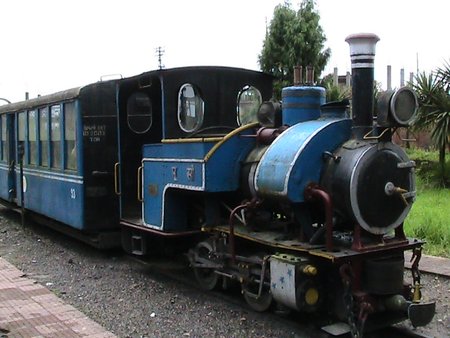DHR Ghoom Museum
DHR Ghum Museum is one of the three museums of Darjeeling Himalayan Railways. It's located at the Ghum railway station premises.
Ghum (also spelt as Ghoom) is India's highest railway station and located at an altitude of 7,400ft. The other two DHR museums are located at Kurseong and Sukna.
In 1999, the famous narrow gauge Toy Train of the Darjeeling Himalayan Railway was accorded the UNESCO World Heritage status. And in the year 2000, the Ghum Museum was established and opened to the visitors to showcase its heritage.
The museum exhibits are spread across two areas: 1) A large but fenced open space next to the railway station which once used to be the goods and locomotives shed, and 2) An indoor museum room which is located upstairs in the station building.
The Outdoor Exhibits
Right opposite the Ghum platform, there is the entry gate to the open-space museum which has a garden-like setting. As you enter through the gate, on your right you will see Baby Sivok... this is the oldest toy train steam engine of Darjeeling Himalayan Railways (DHR). It is no longer in operation, and has found its home here as a museum exhibit.
Baby Sivok, the oldest Toy Train Engine of DHR
Baby Sivok operated on narrow gauge track starting from the year 1881 and provided the first ever rail link through the mountains in Darjeeling Hills. It was last overhauled in 1999 at the Tindharia Workshop which is located on the route to Darjeeling and before Kurseong.
It looks like a small 'B' class steam loco, and that's the reason the word 'Baby' in its name. You can actually see the inside of the engine from a close distance.
Inside view of Baby Sivok, the oldest engine
You can also see a coach attached to it... Coach No. 93, a small coach that was once attached to small steam engines like Baby Sivok. This is the last one of its type existing today. It was built in 1967/68 in Gorakhpur workshop.
Some of such coaches were later modified in 1980s, fitted with large windows and refurbished with toilets at one end. Several of those modified coaches are still in service in Toy Trains of Darjeeling and are used as First Class coaches.
The open space museum arena also has a few other exhibits. One of the other highlights is the 4-wheeled vans that were once used to carry freights or goods from the plains to Darjeeling. They were hauled by the steam locos.
The freight vans on display here operated from the 1940s and were quite common those days. The vans were later discontinued in the 1980s once the roadways between the Siliguri plains and Darjeeling improved which paved the way for road transports.
Other exhibits here include a water tank wagon that was built around 1928, and a 4-wheeled trolley that was used for the maintenance work of the track.
Another exhibit is a weigh bridge that was installed in Sukna. It was used to weigh and limit the vehicles plying on Hill Cart Road (now NH-110) in 1930s because the road was then predominantly meant for the horse-drawn carts (after which the road was so named).
The Indoor Museum Room
From the left end of the open space, there is an wooden stairway that leads to the indoor museum room upstairs. This wooden building houses rare and old artifacts of the Darjeeling Himalayan Railways (DHR) as well as those pertaining to general World Heritage.
Inside DHR Ghum Museum
Photo: Pinakpani, cc by-sa
Several items on display here were donated by the ex-DHR employees. There are also many rare photographs of the DHR Toy Train and its life history. You can see old photographs of landslides and earthquakes that disrupted the DHR Service.
An interesting exhibit here includes a couple of brass bells. The larger one was used to signal the departure of passenger trains while the smaller one was used for signaling the freight trains. You can also see the DHR Guard's uniform, whistles, chairs & desks, etc.
You will find a couple of palanquins in this exhibition room. These were used during the British days to carry elite passengers from Darjeeling station to the hotels. There are also exhibits from the station master's office room, such as a padlock, rule book, etc.
Exhibits at DHR Ghum Museum
Photo: Pinakpani, cc by-sa
The padlock was manufactured in London and was used to lock a metal cupboard which is also on display here. It was due to this padlock that the cupboard survived several attacks during the days of the unrest in the hills.
You will also find metal plates displaying names of the companies that were involved in manufacturing different parts of the DHR trains and the engines. Tindharia Workshop of DHR was one of them, but most others were British companies such as Sharp Stewart & Co, North British Locomotive Company, Baldwin Locomotive Works, etc.
Update: Over the years, the Ghum Station and the DHR Museum had fallen into disrepair. In 2017, they were renovated and restored to the past glory. The station now looks quite colorful and the way it originally used to be.
Watch the video of Ghum Station & Museum
NOTE: This video was taken prior to the renovation and restoration work of the station & museum.
Open Hours & Entry Fee
The DHR Ghum Museum is open between 10am to 1:30pm and again from 2pm until 4pm. There is an entry fee (Rs. 20/- per person, subject to change).
If you plan to take the
Toy Train Joy Ride from Darjeeling which comes up to Ghum and returns, then you can visit the DHR Ghum Museum without any additional cost because the entry fee is part of the Joyride ticket fare. The train stops at the Ghum station for a while and passengers are given free entry to the DHR Museum.
Location
DHR Ghum Museum is located at the Ghum Station premises. The entry is through a gate opposite to the platform. Check out
Ghum Area & Map to see the location.
Related Articles
|
Visitors' Reviews/Comments
Share your experience or stories.
|




